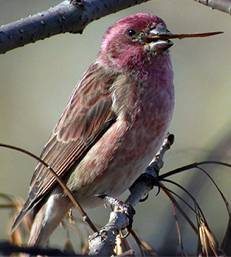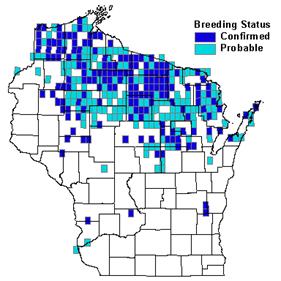Photo by Chuck Heikkinen & Delia Unson


Status/Protection
- Global Rank: G5 Key to global and state ranks
- State Rank: S4B
- WBCI Priority: PIF
Population Information
The Federal BBS information can be obtained at http://www.mbr-pwrc.usgs.gov/bbs/bbs.html by clicking on Trend Estimates and selecting the species in question. All estimates are for time period (1966-2005).
- Federal Breeding Bird Survey: significant decline
- Federal Breeding Bird Survey (WI): non-significant increase
- Federal Breeding Bird Survey (BCR 23): non-significant increase
- Federal Breeding Bird Survey (BCR 12): significant decline
- WSO Checklist Project: stable (1983-2007)
Life History
- Breeding Range: British Columbia east across southern Canada south into the Great Lakes and New England states (Wooten 1996).
- Breeding Habitat: Black Spruce, Swamp Conifer-Balsam Fir, Tamarack, White Cedar, Fir Spruce, White Pine, Open Bog-Muskeg.
- Nest: Cup, usually on branch of a conifer tree (Wooten 1996).
- Nesting Dates: Eggs: late May to early July (Robbins 1991).
- Foraging: Foliage glean (Ehrlich et al. 1988).
- Migrant Status: Short-distance migrant.
- Habitat use during Migration: Similar to winter habitat.
- Arrival Dates: Early April to mid-May (Robbins 1991).
- Departure Dates: Mid-September to mid-November, though frequently winters in Wisconsin (Robbins 1991).
- Winter Range: Northern North America, including Wisconsin, south to northeastern U.S. and along the Pacific Coast (Wooten 1996).
- Winter Habitat: Coniferous, deciduous, and mixed coniferous-deciduous forests, urban and suburban areas, mixed shrub and conifer habitats, weedy fields, and hedgerows (Wootton 1996).
Habitat Selection
The Purple Finch occurs in coniferous forests, mixed conifer-deciduous forests, riparian corridors, and bog edges (Wootton 1996). It nests in moist areas where balsam fir, white cedar, hemlock, spruce, and white pine are the dominant canopy species (Ewart 1991). Nests are generally placed on the horizontal branch of a conifer tree. This species also is tolerant of urban areas where it is a frequent visitor to bird feeders. It occasionally nests near rural farmsteads (Gostomski 2006), orchards, ornamental plantations, pastures and lawns with scattered conifers, and hedgerows (Wooten 1996). Although it is relatively plastic with its habitat use, the Purple Finch seems to prefer habitat with a conifer component (Niemi and Hanowski 1992).
Habitat Availability
The Purple Finch is widely distributed in Wisconsin. In summer, the Purple Finch is a common resident in the northern region of Wisconsin (Robbins 1991) and occurs primarily from Lake Superior south through Wood, Portage, and Waupaca counties (Gostomski 2006). In winter it occurs primarily in the central and southern regions of the state (Robbins 1991) but in some years may be found in significant numbers throughout northern Wisconsin as well. The Purple Finch seems to be relatively adaptable to landscape changes, which implies that abundant habitat is available within the state.
Population Concerns
Breeding Bird Survey data suggest a significant annual decline range-wide but there is little information regarding the causal factors of this decline. Interspecific competition with House Finch may has been implicated in its decline across eastern North America (Wooten 1996), but more study is needed. In Wisconsin the Purple Finch population appears to be increasing, although this trend is not statistically significant (Sauer et al. 2005). Robbins (1991) cites it as a fairly common resident in north and central Wisconsin where it was documented in nearly 15% of the quads surveyed by the Wisconsin Breeding Bird Atlas (Gostomski 2006).
Recommended Management
Little research is available concerning the effects of timber management and land use practices on Purple Finches, particularly in the Great Lakes region. Thus, citing specific management prescriptions would be speculative. Conservation measures that protect existing coniferous forests in the northern half of the state will ensure suitable breeding habitat for this species.
Research Needs
Despite its widespread distribution, the Purple Finch is one of the least studied finches in North America. No formal biological studies have been conducted in Wisconsin, thus much remains to be learned about this species’ requirements. More information is needed on site and landscape-level features important to this species. Research that elucidates the effects of various forest management techniques would further conservation efforts. Finally, more research is needed into factors limiting this species, in particular interspecific competition with House Finch.
Information Sources
- Chequamegon National Forest Bird Survey (NRRI) species account: http://www.nrri.umn.edu/mnbirds/accounts/PUFIa2.htm
- Cornell Lab of Ornithology species account: http://www.birds.cornell.edu/AllAboutBirds/BirdGuide/Purple_Finch.html
- Nicolet National Forest Bird Survey map: http://www.uwgb.edu/birds/nnf/species/PUFI.htm
- North American Breeding Bird Survey: http://www.mbr-pwrc.usgs.gov/bbs/bbs.html
- Temple S.A., J.R. Cary, and R. Rolley. 1997. Wisconsin Birds: A Seasonal and Geographical Guide. Wisconsin Society of Ornithology and Wisconsin Department of Natural Resources, Madison, WI.
- Wisconsin Breeding Bird Atlas: http://www.uwgb.edu/birds/wbba/
References
- Ehrlich, P.R., D.S. Dobkin, and D. Wheye. 1988. The birders handbook: a field guide to the natural history of North American birds. Simon & Schuster, Inc. New York.
- Ewart, D.N. 1991. Purple Finch. In The Atlas of Breeding Birds of Michigan (R. Brewer, G.A. McPeek, and R.J. Adams, eds.). Michigan State University Press.
- Gostomski, T. 2006. Purple Finch. In The Wisconsin Breeding Bird Atlas (N.J. Cutright, B.R Harriman, R.W Howe, eds.) The University of Wisconsin Press: Madison, WI.
- Niemi,G.J. and J.M. Hanowski. 1992. Appendix 4: Detailed species descriptions - forest birds. In Forest wildlife. A technical paper for a generic environmental impact statement on timber harvesting and forest management in Minnesota, Jaakko Poyry Consulting, Raleigh, NC.
- Robbins, S.D. 1991. Wisconsin birdlife: population & distribution, past & present. Univ. of Wisconsin Press, Madison, WI.
- Sauer, J.R., J.E. Hines, and J. Fallon. 2005. The North American Breeding Bird Survey, Results and Analysis 1966 - 2005. Version 6.2.2006. USGS Patuxent Wildlife Research Center, Laurel, MD.
- Wootton, J.T. 1996. Purple Finch (Carpodacus purpureus). In The Birds of North America, No. 208 (A. Poole and F. Gill, eds.). The Academy of Natural Sciences, Philadelphia, and The American Ornithologists’ Union, Washington, D.C.
Contact Information
- Compiler: Kim Kreitinger, K.Kreitinger@gmail.com
- Editor: Ryan Brady, Ryan.Brady@Wisconsin.gov
